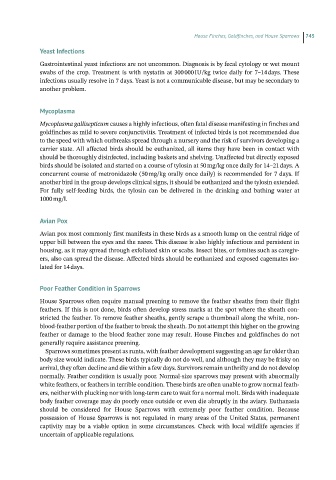Page 743 - Hand rearing birds second
P. 743
House Finches, Goldfinches, and House Sparrows 745
Yeast Infections
Gastrointestinal yeast infections are not uncommon. Diagnosis is by fecal cytology or wet mount
swabs of the crop. Treatment is with nystatin at 300 000 IU/kg twice daily for 7–14 days. These
infections usually resolve in 7 days. Yeast is not a communicable disease, but may be secondary to
another problem.
Mycoplasma
Mycoplasma gallisepticum causes a highly infectious, often fatal disease manifesting in finches and
goldfinches as mild to severe conjunctivitis. Treatment of infected birds is not recommended due
to the speed with which outbreaks spread through a nursery and the risk of survivors developing a
carrier state. All affected birds should be euthanized, all items they have been in contact with
should be thoroughly disinfected, including baskets and shelving. Unaffected but directly exposed
birds should be isolated and started on a course of tylosin at 50 mg/kg once daily for 14–21 days. A
concurrent course of metronidazole (50 mg/kg orally once daily) is recommended for 7 days. If
another bird in the group develops clinical signs, it should be euthanized and the tylosin extended.
For fully self‐feeding birds, the tylosin can be delivered in the drinking and bathing water at
1000 mg/l.
Avian Pox
Avian pox most commonly first manifests in these birds as a smooth lump on the central ridge of
upper bill between the eyes and the nares. This disease is also highly infectious and persistent in
housing, as it may spread through exfoliated skin or scabs. Insect bites, or fomites such as caregiv-
ers, also can spread the disease. Affected birds should be euthanized and exposed cagemates iso-
lated for 14 days.
Poor Feather Condition in Sparrows
House Sparrows often require manual preening to remove the feather sheaths from their flight
feathers. If this is not done, birds often develop stress marks at the spot where the sheath con-
stricted the feather. To remove feather sheaths, gently scrape a thumbnail along the white, non-
blood‐feather portion of the feather to break the sheath. Do not attempt this higher on the growing
feather or damage to the blood feather zone may result. House Finches and goldfinches do not
generally require assistance preening.
Sparrows sometimes present as runts, with feather development suggesting an age far older than
body size would indicate. These birds typically do not do well, and although they may be frisky on
arrival, they often decline and die within a few days. Survivors remain unthrifty and do not develop
normally. Feather condition is usually poor. Normal‐size sparrows may present with abnormally
white feathers, or feathers in terrible condition. These birds are often unable to grow normal feath-
ers, neither with plucking nor with long‐term care to wait for a normal molt. Birds with inadequate
body feather coverage may do poorly once outside or even die abruptly in the aviary. Euthanasia
should be considered for House Sparrows with extremely poor feather condition. Because
possession of House Sparrows is not regulated in many areas of the United States, permanent
captivity may be a viable option in some circumstances. Check with local wildlife agencies if
uncertain of applicable regulations.

